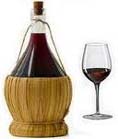Waste Disposal Units
from Italian Traditional Food
Types of waste disposal
units
Check out these great Italian ideas at Amazon for Italian food and kitchen ideas.
This is a short article about waste disposal
units. Even the best cooks have food waste to get rid of and the trips to the dustbin and the struggles
with the pedal-bin are one of the most unattractive by-products of cooking and clearing away a meal.
Every day our use of packages and non-returnable bottles increases
and these have to be disposed of too. But decaying food scraps are far and away the most unpleasant bits of rubbish
and any improvement in the speed and ease of their disposal is welcome.
More information about waste
disposal units
Electric waste disposal units that fit into the sink outlet and grind up scraps of food
(with cold water from the tap so that they disappear down the drain in a fine mush) cut out all that messy business
of pedal-bins and soggy, newspaper-wrapped bundles destined for the dustbin. Some waste disposal units also deal
with paper and cartons. Brands differ in
their capacity for dealing with the more difficult kinds of waste, eg. bacon rinds, large bones, paper. The only
place you are likely to find a list of the fads and fancies of a particular model is in the instruction book you
get after the machine is installed - so to check the machine's appetite and capacity ask to see instruction books
in addition to the glossy sales leaflets of the various models before you make your final choice.
Types of
units
There are two types of waste
disposal units - batch feed and continuous feed. The batch feed unit is filled with waste and the grinders
are switched on only when the plug is put into the outlet. This means that the user cannot get fingers caught in
the grinder when it is in operation. It also means that if you have a large amount of waste you have to keep
reloading the unit.
With the continuous fee unit the
waste is fed in as the unit is running, and there is no doubt that this is simpler and quicker; however, the
rotating grinders are accessible and accidents have occurred because of them.
Installation
Waste disposal
units can be fitted on to a kitchen sink if the waste outlet is three and a half to four
inches in diameter. If you are buying a new sink, three and a half inch outlet holes are available and most
models cost no more than those with one and a quarter inch holes. With existing sinks there may be problems,
although existing stainless steel sinks can quite easily have the one and a quarter inch hole enlarged to
three and a half inches in diameter.
Existing fireclay sinks cannot be
modified, but new models are available with the right size hole. Some manufactures of waste disposal units have
adaptors which will enable their units to be used with the extra thickness of a fireclay sink. Existing vitreous
enamel sinks can often have the outlet hole enlarged with a special cutter, but there is always a likelihood that
the enamel will chip in the process. In existing sinks, the waste pipe will also need modification in some
way.
In addition to plumbing alterations, there is also the electrical
installation. A switched power point (13 or 15 amp) must be reasonably near the unit. It should, however, be fitted
well out of reach of small children. Units can be used where there are septic tanks but local authorities will not
usually grant permission where drainage is to one with less than 500 gallons capacity.
Page 2 of this Italian Traditional Food article about waste disposal units can be found on the
next page.
Page 1 Next
>>

Copyright © 2009 - .
All Rights Reserved Worldwide. Italian Traditional Food
You may not reprint articles from this website
without the written permission of the site owner.
Disclaimer: Articles on this
Website are provided for information purposes only. Italiantraditionalfood.com does not accept any responsibility
or liability for the use or misuse of the article content on this site or reliance by any person on the site's
contents.
| 


 Digg
Digg Stumbleupon
Stumbleupon Google Bookmarks
Google Bookmarks Delicious
Delicious Twitter
Twitter Facebook
Facebook Yahoo My Web
Yahoo My Web Reddit
Reddit